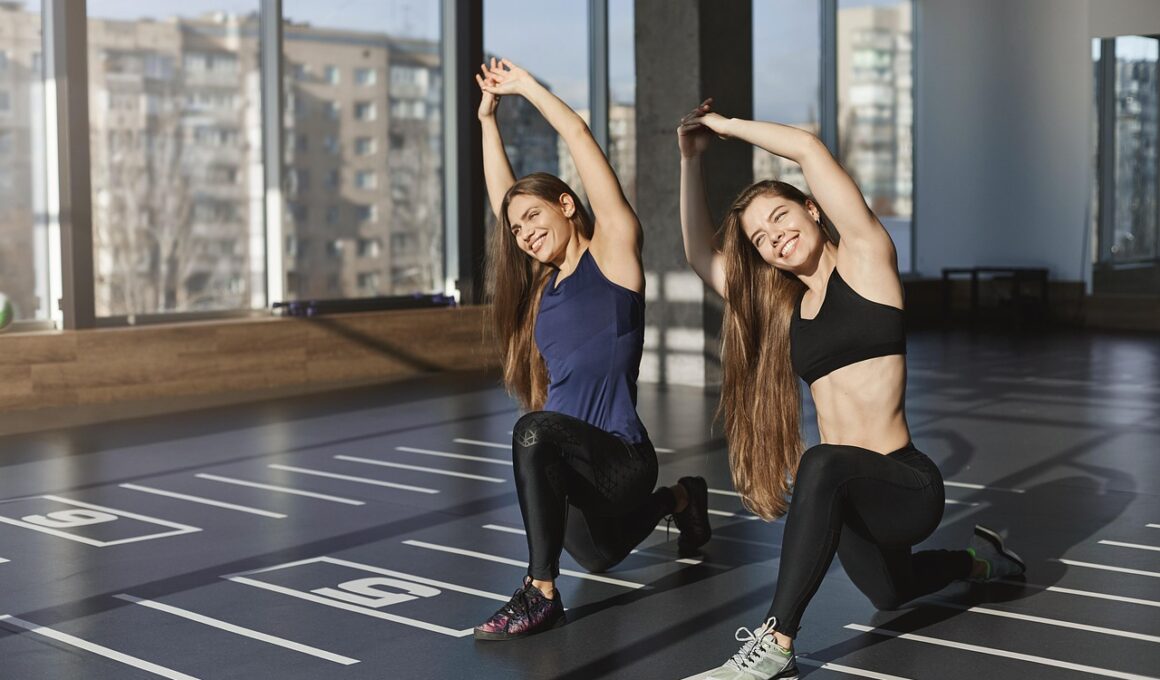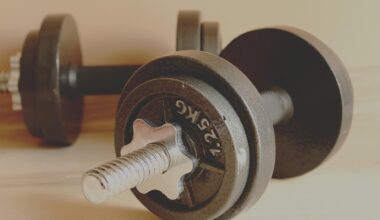Incorporating Fitness into Daily Activities for Women with Little Time
In today’s fast-paced world, women often struggle to find time for fitness. However, prioritizing physical health is crucial. The key lies in incorporating fitness into daily routines rather than setting aside separate time. Embracing small activities can yield significant benefits. For instance, choosing to walk rather than drive for short distances not only fits exercise into busy schedules but also promotes health in daily life. Furthermore, using stairs instead of elevators can help burn extra calories throughout the day. Even short workouts during breaks or at home can make a difference. The intention to move more during the day is vital. Consider using household chores as an opportunity for fitness; tasks like vacuuming or gardening offer great calorie-burning benefits. Another helpful idea is to use a fitness tracker. It encourages daily activity while providing useful insights. By focusing on integrating fitness into existing daily tasks, women can effectively manage their time and improve their well-being without requiring extensive planning or scheduling.
Maximizing Short Workouts
Short workouts can be highly effective, especially for time-strapped women. These brief but intense sessions, often lasting just 15 to 30 minutes, can fit seamlessly into busy schedules. High-Intensity Interval Training (HIIT) is one excellent option, as it provides substantial fitness benefits in minimal time. Studies indicate that short bursts of intense exercise can enhance cardiovascular health and build muscle strength efficiently. Online resources and apps can help access guided workouts that require little to no equipment, making accessibility simpler. Moreover, working out at home eliminates the time needed to commute to a gym. Women can also leverage technology by participating in virtual fitness classes. Scheduling short workout sessions during lunch breaks or immediately after waking up can keep motivation high and consistency regular. Engaging in physical activities with family members can also boost accountability and enjoyment. To sustain results, remember to mix up exercises to prevent monotony. Incorporating strength training, cardio, and flexibility exercises adds variety and overall health benefits. Ultimately, even small, consistent efforts contribute to achieving fitness goals.
Incorporating fitness into social activities is another effective strategy. Women can merge exercise with social interactions by engaging in activities like walking, jogging, or cycling with friends. This not only reinforces relationships but also keeps everyone accountable to their fitness goals. Book clubs often can swap sitting for standing by meeting while walking. Pursuing outdoor adventures with peers promotes physical activity, health, and enjoyment. Additionally, consider exploring local fitness classes, which often cater to various skill levels and preferences. Opting for group fitness sessions, such as Zumba or yoga, can be a fun way to bond with friends while remaining active. By investing in social fitness, women create a supportive environment that encourages regular participation in physical activities. Even hosting workout parties can transform a typical gathering into an energizing event. As friendships grow stronger alongside personal fitness, motivation thrives and promotes commitment to healthy living. Consequently, women discover that cultivating both social networks and fitness routines provides a holistic approach to health and wellbeing.
Mindfulness is another vital factor influencing women’s fitness and time management. Integrating mindfulness into workouts can strengthen both physical and mental health. Yoga practices, for example, allow individuals to tune into their bodies while focusing on breath, enhancing overall well-being. Additionally, meditative techniques can help manage stress, which often impedes fitness goals. Setting intentions for workouts fosters a clearer mindset, resulting in a more fulfilling fitness experience. By practicing mindfulness, women can learn to appreciate movement rather than viewing exercise as a chore. Simple breathing exercises throughout the day can re-center oneself and increase overall energy levels. Another remarkable technique to practice mindfulness involves staying present during daily activities, including workouts. Exploring nature can elevate moods and reduce stress levels, serving as an excellent workout. Prioritizing a strong connection between mental and physical health allows women to nurture both aspects simultaneously. Consequently, understanding how to balance fitness and mindfulness can lead to improved self-awareness, resilience, and a healthier lifestyle.
Setting Realistic Goals
Setting realistic and achievable fitness goals is integral for managing time effectively. Women should begin with specific objectives, focusing on what they wish to accomplish. Whether wanting to improve strength, increase endurance, or maintain flexibility, having a clear goal helps direct training and activities. Short-term goals create tangible milestones leading to larger aspirations, reinforcing motivation along the way. Keeping these goals manageable and adjusting them as life changes can help maintain persistence in fitness journeys. Tracking progress through journals or apps can serve as both motivational and rewarding. Additionally, women should embrace flexibility in their goals to accommodate life’s unpredictability. Recognizing that wellness is a lifelong journey allows for compassionate self-reflection and improvement. When setbacks occur, reframing the challenges positively can keep spirits high and intentions aligned. Ultimately, maintaining an open mindset about fitness leads to balanced, healthy living. Instead of all-or-nothing attitudes, women must learn to celebrate small wins and progress toward larger goals, ensuring sustainable engagement in physical fitness.
Education plays a crucial role in women’s fitness management. Understanding the fundamentals of nutrition and exercise can empower individuals to make informed decisions. Access to reliable resources informs women about optimizing meals that fuel their bodies for workouts. Learning about portion control, balanced meals, and healthy snacks can make food choices more manageable in busy lives. Participating in workshops or online courses focused on women’s health enhances knowledge and fosters community connections. Additionally, following reputable fitness professionals on social media provides insight into new trends, tips, and motivating stories from fellow women. Engaging in discussions with nutritionists can offer personalized advice tailored to individual lifestyles. Consistently educating oneself about health encourages proactive behavior in nutrition and fitness management. Women should aim not only to learn but also to apply this knowledge practically, testing its effectiveness on their personal fitness journeys. Creating supportive environments where discussions about health thrive cultivates a culture of empowerment, motivation, and commitment to fitness and wellness.
Finally, remember the importance of rest and recovery in fitness management. Balancing physical activity with adequate rest is crucial for achieving long-term goals. Overworking the body can lead to injuries, fatigue, or burnout, ultimately hindering progress. Women must prioritize recovery strategies, such as sleep, hydration, and proper nutrition, to rejuvenate their bodies. Cultivating a regular sleep schedule enhances recovery and overall well-being. Integrating gentle stretching or relaxation techniques encourages muscle recovery while maintaining engagement with physical health. Scheduling downtime allows for mental clarity and stress relief, essential for holistic wellness. Additionally, women should listen to their bodies and recognize signs of needing rest or adjustments in their routines. By adopting a balanced approach toward fitness, women empower themselves to sustain long-lasting commitments to their health and fitness journeys. Understanding that rest is not a weakness, but rather a necessary component of success, fosters a healthier relationship with exercise and personal well-being.
Therefore, integrating fitness into daily life for women with limited time is entirely feasible. By prioritizing movement, setting achievable goals, and seeking education while allowing for rest, women can thrive in their fitness journeys. Embrace the power of small, consistent efforts, and cherish the journey toward improved health and wellness. Ultimately, each step toward fitness cultivates confidence and resilience, enriching lives on numerous levels. The journey to incorporate fitness into daily routines can ignite motivation and solidarity among women. Sharing experiences, motivating each other, and celebrating progress together fosters a culture of health and wellness. Managing time effectively while prioritizing fitness leads to a richer, more fulfilling life. Engaging in playful activities or trying something new can also spark excitement, allowing for physical engagement to become an enjoyable part of life rather than a burden. With determination and creativity, every woman can find ways to enhance her fitness journey within her daily activities, leading to a happier and more active lifestyle.


